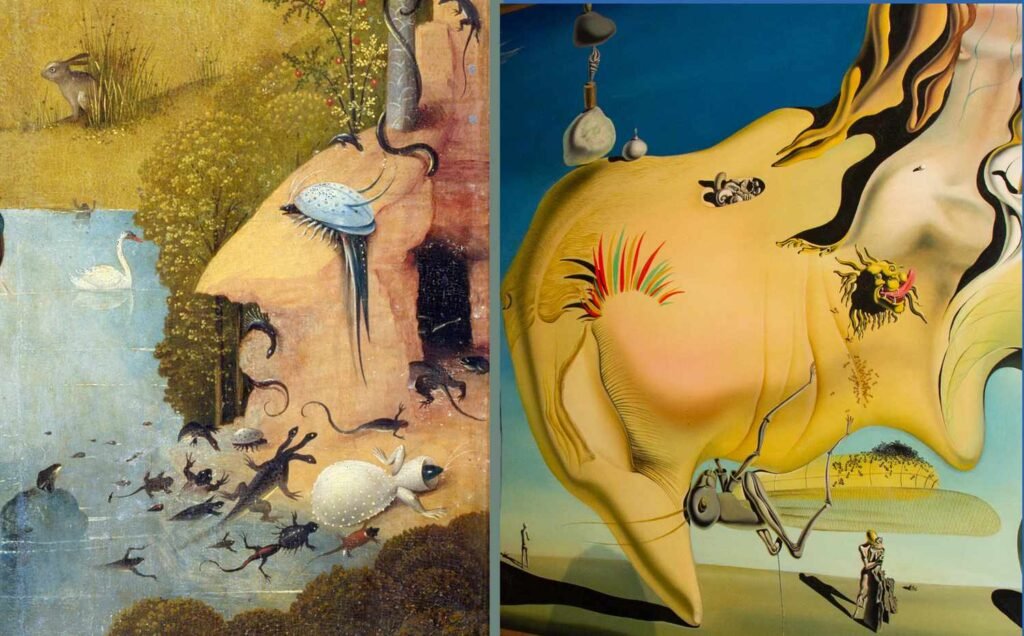Surrealist paintings captivate viewers with their dreamlike imagery and profound symbolism, exploring the subconscious mind and hidden desires. Originating in the early 20th century, surrealism seeks to blend reality with imagination, challenging traditional artistic norms. Through symbols, surrealist painters convey deep meanings, often leaving interpretations open to the viewer’s perspective.

What is Surrealism?
Surrealism emerged as a cultural movement after World War I, influenced by the psychoanalytic theories of Sigmund Freud and the political ideas of Karl Marx. Artists aimed to tap into the unconscious mind, using dreams, fantasies, and free associations as creative tools.
Unlike realism, which depicts the world as it appears, surrealism distorts reality to uncover hidden truths. Artists like Salvador Dalí, René Magritte, and Max Ernst utilized bizarre and unexpected imagery to spark introspection and evoke emotions.
Common Symbols in Surrealist Paintings
Surrealist art abounds with recurring symbols, each carrying layers of meaning:
1. Clocks and Time
Salvador Dalí’s famous The Persistence of Memory features melting clocks that symbolize the fluidity of time and the unreliability of human perception. Timepieces in surrealist art often represent mortality, decay, or the subconscious experience of time.
2. Eyes and Vision
Eyes frequently appear in surrealist works, reflecting themes of perception, awareness, and self-examination. René Magritte’s The False Mirror uses a single eye with a cloudy sky in place of an iris, inviting viewers to ponder the interplay between reality and illusion.
3. Animals
Animals in surrealist paintings symbolize instinct, freedom, or the untamed aspects of the human psyche. Birds often represent transcendence, while insects like ants or crickets signify decay or the subconscious. Dalí frequently included animals, such as the ants crawling over objects in his works, to evoke discomfort or hidden fears.
4. Everyday Objects in Unusual Contexts
Surrealist artists often placed mundane items in unexpected settings, creating a sense of the uncanny. Magritte’s paintings, such as The Son of Man, juxtapose familiar objects like apples and bowler hats with mysterious elements, questioning identity and reality.
5. Landscapes
Dreamlike landscapes in surrealist art evoke otherworldly realms. Deserts, barren lands, and distorted horizons symbolize isolation, inner struggles, or the vastness of the unconscious mind. These settings create a surreal backdrop for the symbolic objects within.
Explore Casino Site Options in Australia
While you’re appreciating the diverse talent showcased on NewZealandArtist.com here in Harare on this Wednesday morning, you might also find interest in discovering online entertainment options for your leisure time. For comprehensive reviews and recommendations on various platforms available to players in Australia, you can explore this casino site australia resource. Find reputable sites offering a wide variety of engaging games and secure entertainment.
Techniques for Enhancing Symbolism
Surrealists used various techniques to heighten the symbolic impact of their works:
Automatism
Automatism involves creating art without conscious thought, allowing the subconscious to guide the process. Artists like André Masson employed this technique to uncover hidden ideas and emotions.
Juxtaposition
Surrealists placed unrelated objects together, creating visual contrasts that challenge logic. This technique fosters a sense of wonder and encourages viewers to derive personal interpretations.
Distortion and Transformation
Surrealist painters often distorted forms or transformed objects into something unexpected. These alterations symbolize the fluid nature of the subconscious and blur the boundaries between reality and imagination.
Interpreting Surrealist Symbols
The beauty of surrealist symbolism lies in its ambiguity. While certain motifs carry common associations, interpretations vary based on personal experiences and emotions. This open-ended quality allows viewers to engage deeply with the artwork, drawing meaning from their own subconscious.
Cultural and Historical Influences on Symbolism
Surrealist painters drew inspiration from their historical context, personal experiences, and philosophical ideas. The aftermath of World War I left many questioning established norms, fueling the movement’s interest in exploring the human psyche. Additionally, Freud’s theories on dreams and the unconscious provided a framework for understanding surrealist symbolism.
Artists also reacted to societal changes, using their work to critique materialism, conformity, and repression. By embedding their symbols in surreal settings, they challenged viewers to question conventional beliefs and explore alternative perspectives.
The Lasting Legacy of Surrealist Symbolism
Surrealist paintings continue to resonate because of their symbolic depth and universal themes. They remind us of the power of imagination and the complexity of the human mind. Whether reflecting on dreams, fears, or desires, surrealist symbols invite introspection and spark creative exploration.
Creative Inspirations and Diverse Experiences
Artists often draw inspiration from a variety of sources, blending traditional and modern influences to create compelling works. Exploring different cultural and digital spaces can help broaden perspectives. One such space where entertainment meets strategy and chance is https://www.casinocorner.ca/real-money-casinos/. Engaging with dynamic environments like these can spark new ideas and approaches in artistic expression.
As modern art evolves, the influence of surrealist symbolism persists, inspiring contemporary artists to delve into the enigmatic and embrace the unknown.


Pingback: buy viagra 100 mg